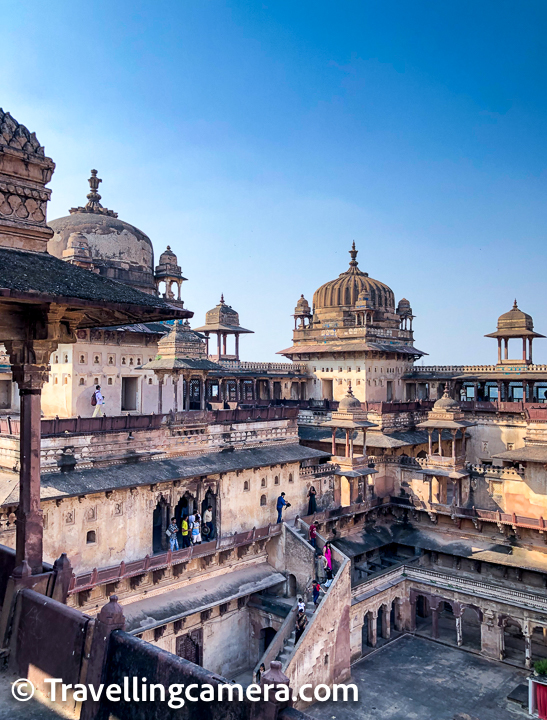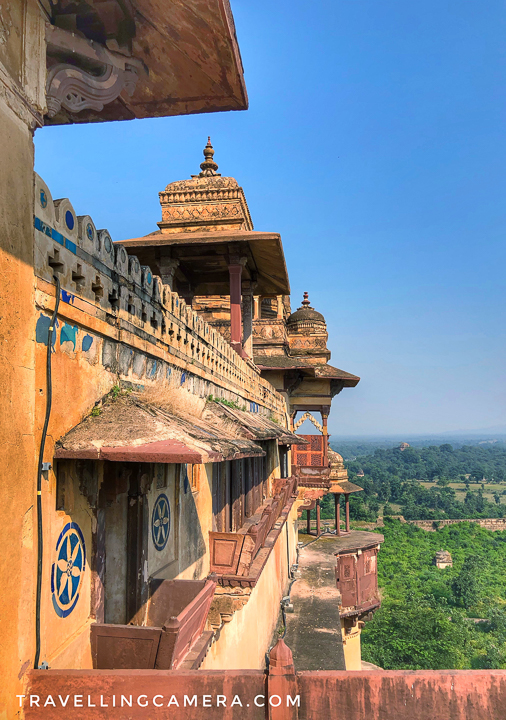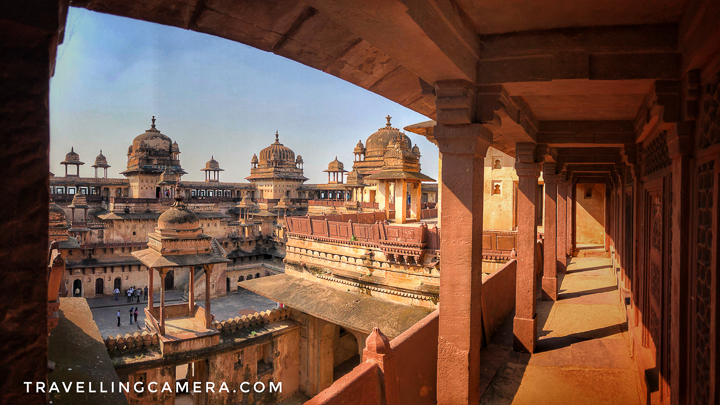The Marvels of the Orchha Palace Complex || A Stunning, Solid & Complex Architectural masterpiece that came up over the centuries
Forts and palaces hold a special place in my heart. The atmosphere, the mystery, and the fact that these buildings have seen centuries of histories unfold within their walls - well, what more can a romantic seek. The walls that stand strong against the tide of time have also played confidante to generations of families celebrating festivals and happy tidings, going through turmoil, and at times plotting against each other. Several clandestine affairs have unfurled within these chambers, often resulting in tragedy. So there is so much material for a writer and a poet.
Related Blogpost - Orchha, Madhya Pradesh || The hidden land that adopted Lord Ram as their King in the 16th Century
When compared to some of the other forts of India, the Orchha fort seems in a fairly good shape. It is built of red and yellow sandstone and has weathered well. The carvings are still intact and the murals, though faded, can still be made out. If you look out from the latticed windows of the Jahangir Mahal, you can take in the lush green plans that surround the Palace complex and also at the smaller monuments that dot the landscape.
Like many forts, the Orchha fort also houses several monuments within its boundaries, including the ones that are across the bridge that connects the Orchha Palace with Orchha town. But in this post, we will talk about the monuments within the Orchha Palace complex. The oldest among these is the Raja Mahal, which was built in the early 16th century.
The construction was started by the Bundela King Rudra Pratap Singh right after he founded Orchha. However, the King never really got to enjoy the fruit of his labour. By the time the construction completed (which did not take too long - a couple of years at max), the King had died and his descendent Bharti Chand, who ruled from 1531 to 1554 added some finishing touches to the palace.
Related Blogpost - Stunning Bateshwar Group of Temples || Archaeological marvels at Padavali in Morena District of Madhya Pradesh
The Raja Mahal appears to be a very simple and unimposing structure from outside (more so since there are other palaces within the complex that are much more imposing and opulent). However, when you go inside, you find the remains of intricate artwork and grand murals on the ceilings and walls. The Mahal is rumored to have several hidden passages and narrow stairways to higher floors. All very interesting to explore.
The Mahal also has a pillared structure, known as "Diwan-e-aam", where the Raja would meet the aam junta and resolve disputes etc. When we got here, we found the place overrun by a band of langoors and it looked pretty dangerous to explore. So we avoided it altogether. Then there was also the "Diwan-e-khas" where the Raja would meet his close confidantes.
After King Bharti Chand, his younger brother Madhukar Shah took over and added a few embellishments to the Palace. However, one of the most important addition to the Palace complex was done by Raja Bir Singh Deo (Madhukar Shah's son). Bir Singh Deo was a close friend of Emperor Jahangir, having helped assassinate Abul Fazl, one of the navratns of Badshah Akbar, who was also one of the only obstacles in Shehzada Salim (later Jahangir) ascending the throne after his father.
This friendship between Bir Singh Deo and Emperor Jahangir proved to be very beneficial for Orchha. So when Emperor Jahangir was scheduled to visit Orchha, Bir Singh Deo ordered a new palace to be built for the emperor. This palace would sit higher than any other monument in Orchha and would be known as Jahangir Palace. The palace was built in the early 17th century.
Jahangir Palace is a shining example of the fusion of Bundela and Mughal architectures. The high domes, ornate arched doorways, latticed windows, and the traces of green color on the walls allude to the Mughal style whereas the canopies, balconies, and remnants of blue paint is a mark of the Bundelas and the local architecture.
One of the most recent additions to the Orchha Palace is the Sheesh Mahal, which was constructed in the 18th century by one of the later Bundela kings, Udwat Singh. His aim was to create something more ornate than the existing palaces and, yes, he succeeded. The Sheesh Mahal is now a hotel run by Madhya Pradesh Tourism and you cannot really go inside unless you are a guest or plan to have a meal at their expensive-looking restaurant. We did not visit this monument, but parked our can several times right outside it.
Apart from this, there are few more monuments to see within the Orchha fort complex. One of them is the Rai Pravin Mahal. We missed going here because of lack of information (our mistake, we did not do enough research), though we did manage to take a picture of it through one of the windows of Jahangir Mahal. The history associated with this mahal is a very interesting one.
Related Blogpost - Chausath Yamini Temple @ MItawali in Morena region of Madhya Pradesh, India
As per the legend, Pravin Rai was an extremely talented poet and singer. She was the favorite courtesan of Bundela King Indrajit Singh. She was also known as the "nightingale of Orchha". News about her many talents spread far and wide and she was summoned by Badshah Akbar to become a part of his harem.
However, when she reached there, she recited a couplet in the court that could be loosely translated to mean "only scavengers eat from a plate that has already been touched by another person." The emperor understood that Pravin was in love with someone else and impressed by her wit, he sent her back to Orchha with honor.
Related Blogpost - Suhania Kakanmath Temple in Morena region of Madhya Pradesh, India
It is rumored that Pravin Rai was in love with the Bundela King Indrajit Singh (who was a prince at that time) and the prince too reciprocated the feelings. Upon her return, the prince ordered the Rai Pravin Mahal to be built for her. The three-storied mahal is also known as Tope Khana because later it served as a lookout for the Orchha fort as well.
Related Blogpost - Spots and Stripes at Panna National Park || Guess what we saw at the Tiger Reserve
In fact if you happened to go to the terrace of the Jahangir Mahal or look out of one of the windows, you would notice several small monuments that might be worth a visit. From the Jahangir Palace you can also look out at the entire Orchha Town. It is quite beautiful actually.
Related Blogpost - Khajuraho one day Itinerary - How to spend a day around this World Heritage City of Madhya Pradesh in best way ?
We did drive around a bit, but in retrospect, we could have done more. However, it is also tiring to climb all the steep stairs to explore these palaces properly. May be one should plan for two days to explore the Orchha fort complex. One day dedicated to the palace complex only.
If you are here, also plan to attend the sound and light show in the evening. The show covers a history of Orchha over centuries and is like an old photo album that captures snapshots over the years. It spotlights over several important incidents while skimming over the timeline with its narration. The setting is quite mesmerizing actually.
Some things to keep in mind while visiting Orchha:
- There is one single ticket for all historical monuments in Orchha including the Palace, Chaturbhuj temple, Chhatris, Laxmi Narayan Temple, etc. And that can be purchased at the Palace only.
- The ticket is Rs. 20 per person for Indian citizens + Rs 25 for camera. This is quite reasonable considering that this also serves as a day pass for all the other monuments.
- You can take your vehicle right up to Jahangir Mahal and also drive around. The roads are narrow but decent enough. There are no parking charges if you take your vehicle inside the Palace complex.
- If you are parking outside, the ticket is Rs. 30 per person, and the ticket is valid almost all over Orchha.
Overall, the Palace Complex is beautiful and definitely worth a visit and even a repeat visit. When we visited, it wasn't too crowded because of Covid-19, but in regular days, it will probably be crowded. However, the palace is extremely clean and that is a wonderful thing, really. Carry beverages and snacks, but please don't litter.
If you liked this post and found it helpful, I would request you to follow these things when traveling -
1. Manage your waste well and don’t litter Use dustbins.
2. Tell us if you went to a place and found it hard to locate a dustbin.
3. Avoid bottle waters in hills. Usually you get clean water in hills and water bottles create lot of mess in our ecosystem.
4. Say big no to plastic and avoid those unhealthy snacks packed in plastic bags. Rather buy fruits.
5. Don't play loud blaring music in forests of jungle camps. You are a guest in that ecosystem and disturbing the locals (humans and animals) is not polite.






























.jpg)